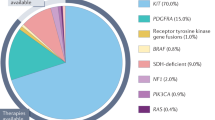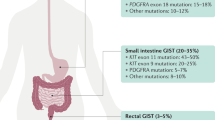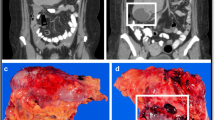Abstract
In the last few years a body of knowledge has been generated on the molecular basis of gastrointestinal stromal tumors (GIST). These mesenchymal tumors are characterized by the expression of KIT protein and because they have an activating mutation in a class III receptor tyrosine kinase gene (KIT or PDGFRA). Several KIT-activating mutations, which are largely responsible for the development of this tumor, promote cell survival, proliferation, and migration through different pathways such as MAPK p42/44, AKT, S6K, STAT1, and STAT3. Likewise, gene-activating mutations in the gene PDGFRα which codes for the receptor tyrosine kinase, Platelet-derived growth factor receptor α have been identified in GIST lacking KIT mutations. This means that KIT and PDGFRα mutations appear to be alternative and mutually exclusive oncogenic pathways for GIST development.
These tumors may occur anywhere along the gastrointestinal tract (GI). The most frequently involved sites are stomach and small intestine. They are typically chemo- and radioresistant. The discovery of a specific inhibitor of this tyrosine kinase, imatinib mesylate, has radically changed the prognosis of patients with unresectable disease. Only 4 yr after the first patient was successfully treated with imatinib, multiple phase II and III trials have been published and, currently, imatinib mesylate is the only effective systemic treatment available of these tumors. Response rates are approximately 70–90% with acceptable toxicity. GIST are the first model of a solid tumor efficiently treated with a molecular-targeted agent. This review summarizes the clinical and biological aspects of this unique neoplasm.
Similar content being viewed by others
References
Demetri GD. OncoloGIST, BioloGIST, RadioloGIST: the big impact on the field of oncology of a molecularly-targeted therapy designed to treat a rare disease. Eur J Cancer 2003; 39: 1976–1977.
Miettinen M, Sarlomo-Riala M, Lasota J. Gastrointestinal stromal tumors: recent advances in understanding of their biology. Hum Pathol 1999; 30: 1213–1220.
Judson I. Gastrointestinal stromal tumors (GIST): biology and treatment. Ann Oncol 2002; 13(Suppl 4):287–289.
Mazur MK, Clark HB. Gastric stromal tumors: reappraisal of histogenesis. Am J Surg Pathol 1983; 7: 507–519.
Thomsen L, Robinson TL, Lee JC. Interstitial cells of Cajal generate a rhythmic pacemaker current. Nat Med 1998; 4: 848–851.
Kindblom L-G, Remotti HE, Aldenborg F. Gastrointestinal pacemaker cell tumor (GIPACT): gastrointestinal stromal tumors show phenotypic characteristics of the interstitial cells of Cajal. Am J Pathol 1998; 152: 1259–1269.
Rubin BP, Fletcher JA. Molecular insights into the histogenesis and pathogenesis of gastrointestinal tumors. Int J Surg Pathol 2000; 8: 5–10.
Miettinen M, Sarlomo-Rikala M, Kovatich AJ, Lasota J. Calponin and h-caldesmmon in soft tissue tumors. Consistent h-caldesmon immunoreactivity in gastrointestinal stromal tumors indicates traits of smooth musche differentiation. Mod Pathol 1999; 12: 756–762.
Berman J, O’Leary TJ. Gastrointestinal stromal tumor workshop. Hum Pathol 2001; 32: 578–582.
Emory TS, Sobin LH, Lukes L. Prognosis of gastrointestinal smooth-muscle (stromal) tumors. Dependence of anatomic site. Am J Surg Pathol 1999; 23: 82–87.
Yarden Y, Kuang WJ, Yang-Feng T. Human proto-oncogene c-kit: a new cell surface receptor tyrosine kinase for an unidentified ligand. EMBO J 1987; 6: 3341–3351.
Blume-Jenssen P, Claesson-Welsh L, Siegbahn A. Activation of the human c-kit product by ligand-induced dimerization mediates circular actin reorganization and chemotaxis. EMBO J 1991; 10: 4121–4128.
Russell ES. Hereditary anemias of the mouse. A review for geneticists. Adv Genet 1979; 20: 357–459.
Kitamura Y, Gos S. Decreased production of mast cells in S1/S1d anemic mice. Blood 1979; 53: 492–497.
Paner GP, Silberman S, Hartman G, Micetich KC, Aranha GV, Alkan S. Analysis of signal transducer and activator of transcription 3 (STAT3) in gastrointestinal stromal tumors. Anticancer Res 2003; 23: 2253–2260.
Duffaud F, Blay JY. Gastrointestinal stromal tumors: biology and treatment. Oncology 2003; 65: 187–197.
Dolci S, William DE, Ernst MK. Requirement for mast cell growth factor for primordial germ cell survival in culture. Nature 1991; 352: 809–811.
Demetri G. Targeting c-kit mutations in solid tumors: scientific rationale and novel therapeutic options. Semin Oncol 2001; 28(Suppl 17):19–26.
Tian Q, Frierson HFJ, Krystal GW. Activating c-kit mutations in human germ cell tumors. Am J Pathol 1999; 154: 1643–1647.
Sekido Y, Obada Y, Ueda R. Preferential expression of c-kit protooncogene transcripts in small cell lung cancer. Cancer Res 1991; 51: 2416–2419.
Beghini A, Cairoli R, Morra E. In vivo differentiation of mast cells from acute myeloid leukemia blasts carring a novel activating lingand-independent c-kit mutation. Blood Cells Mol Dis 1998; 24: 262–270.
Nishida T, Hirota S. Taniguchi M. Familial gastrointestinal stromal tumors with germline mutations of the KIT gene. Nat Genet 1998; 19: 323–324.
Isozaki K, Terris B, Belghiti J. Germline activating mutation in the kinase domain of KIT gene in familial gastrointestinal stromal tumors. Am J Pathol 2000; 157: 1581–1585.
Taniguchi M, Nishida T, Hirota S. Effect of c-kit mutation on prognosis of gastrointestinal stromal tumors. Cancer Res 1999; 59: 4297–4300.
Hirota S, et al. Gain of function mutation of c-kit in human gastrointestinal stromal tumors. Science 1998; 279: 577–580.
Singer S, et al. Prognostic value of kit mutation type, mitotic activity, and histologic subtype in gastrointestinal stromal tumors. J Clin Oncol 2002; 20: 3898–3905.
Lux ML, Rubin BP, Biase TL. KIT extracellular and kinase domain mutations in gastrointestinal stromal tumors. Am J Pathol 2000; 156: 791–795.
Rubin BP, Singer S, Tsao C. KIT activation is a ubiquitous feature of gastrointestinal stromal tumors. Cancer Res 2001; 61: 8118–8121.
Florov A, et al. Response markers and the molecular mechanisms of action of imatinib mesylate in gastrointestinal stromal tumors. Mol Cancer Ther 2003; 2: 699–709.
Duensig A, Medeiros F, McConarty B, Joseph NE, Panigraphy D, Singer S. Mechanisms of oncogenic KIT signal transduction in primary gastrointestinal stromal tumors (GISTs). Oncogene 2004; 23: 3999–4006.
Hong L, Munugalavadla V, Kapur R. c-Kit mediated over-lapping and unique functional and biochemical outcomes via diverse signaling pathways. Mol Cell Biol 2004; 24: 1401–1410.
Heinrich MC, Rubin BP, Longley BJ. Fletcher JA. Biology and genetic aspects of gastrointestinal stromal tumors: KIT activation and cytogenetic alterations. Hum Pathol 2002; 33: 484–495.
Linnekin D. Early signaling pathways activated by c-kit in hematopoietic cells. J Biochem Cell Biol 1999; 31: 1053–1074.
Taylor ML, Metcalfe DD. Kit signal transduction. Hematol Oncol Clin N Am 2000; 14: 517–535.
Aaronson DS, Horvath CM. A road map for those who don’t know. JAK-STAT. Science 2002; 296: 1653–1655
Weiler SR, et al. JAK2 is associated with the c-kit proto-oncogene product and is phosphorylated in response to stem cell factor. Blood 1996; 87: 3688–3693.
Bowman T, Garcia R, Turkson J, Jove R. STATs in oncogenesis. Oncogene 2000; 19: 2474–2488.
Heinrich MC, Corless CL, Duensing A. PDGFRA activating mutations in gastrointestinal stromal tumors (abstract). Science 2003; 299: 708–710.
Gibbons SJ, et al. Kit/stem cell factor receptor-induced phosphatidylinositol 3′ kinase signaling is not required for normal development and function of interstitial cells of Cajal in mouse gastrointestinal tract. Neurogastroenterol Motil 2003; 15: 643–653.
Demetri G. Targeting the molecular pathophysiology of gastrointestinal stromal tumors with imatinib. Mechanisms, successes, and challenges to rational drug development. Hematol Oncol Clin N Am 2002; 16: 1115–1124.
Nishida T, Hirota S. Biological and clinical review of stromal tumors in the gastrointestinal tract. Histol Histopathol 2000; 15: 1293–1301.
DeMatteo RP, Lewis JJ, Leung D, Mudan SS. Woodruff JM, Brennan MF. Two hundred gastrointestinal stromal tumors: recurrence patterns and prognostic factors for survival. Ann Surg 2000; 231: 51–58.
Carney JA. The triad of gastric epthelioid leiomyosarcoma, functioning extra-adrenal paraganglioma, and pulmonary chondroma. Cancer 1979; 43: 374–382.
DeMatteo RP. The GIST of targeted cancer therapy: a tumor (gastrointestinal stromal tumor), a mutated gene (c-kit), and a molecular inhibitor (STI 571). Ann Surg Oncol 2002; 9: 831–839.
Pidhorecky I, Cheney RT, Kraybill WG. Gastrointestinal stromal tumors: current diagnosis, biologic behavior and management. Ann Surg Oncol 2000; 7: 705–712.
Joensuu H, Fletcher C, Dimitrijevic S, Silberman S, Roberts P, Demetri G. Management of malignant gastrointestinal stromal tumors. Lancet Oncol 2002; 3: 655–664.
Gayed I, et al. The role of 18F-FDG-PET in staging and early prediction of response to therapy of recurrent gas-trointestinal stromal tumors. J Nucl Med 2004; 45: 17–21.
Joensuu H, Roberts PJ, Sarlomo-Rikala M. Effect of the tyrosine kinase inhibitor STI 571 in a patient with a metastatic gastrointestinal stromal tumor. N Engl J Med 2001; 344: 1052–1056.
Van den Abbeele AD, Badawi R. Use of positron emision tomography in oncology and its potential role to assess response to imatinib mesylate therapy in gastrointestinal stromal tumors (GISTs). Eur J Cancer 2002; 38:S60-S65.
Van der Abbeele AD, for GIST collaborative PET Study Group. F18-FDG-PET provides early evidence of biological response to ST1571 in patients with malignant gastrointestinal tumors. J Clin Oncol 2001; 19:a1444.
Ng EH, Pollock RE, Munsell MF, Atkinson EN, Romsdahl MM. Prognostic factors influencing survival in gastrointestinal leiomyosarcomas. Implications for surgical management and staging. Ann Surg 1992; 215: 68–77.
Bakshi CA, Jain RA, Sastry PSRK, Sainani AR, Advani SH. Imatinib in gastrointestinal stromal tumors. JAPI 2004; 52:403–409.
Heinrich MC, Girrith DJ, Druker BJ. Inhibition of c-kit receptor tyrosine kinase activity by STI571, a selective tyrosine kinase inhibitor. Blood 2000; 96: 925–932.
Tuveson DA, et al. STI571 inactivation of the gastrointestinal stromal tumor c-KIT oncoprotein: biological and clinical implications. Oncogene 2001; 20: 5054–5058.
Manley PW, et al. Imatinib: a selective tyrosine kinase inhibitor. Eur J Cancer 2002; 28(Suppl 5):S19–27.
Buchdunger E, O’Reilly T, Wood J. Pharmacology of imatinib (STI571). Eur J Cancer 2002; 38(Suppl 5):S28-S36.
van Oosterom AT, Judson I, Verwejj J. Efficacy and safety of imatinib (STI571) in metastatic gastrointestinal stromal tumors. A phase I study. Lancet 2001; 358: 1421–1423.
Demetri GD, von Mehren M, Blanke CD. Efficacy and safety of imatinib mesylate in advanced gastrointestinal stromal tumors. N Engl J Med 2002; 347: 472–480.
Verweij J, van Oosterom AT, Blay JY, Roden-huis S, van der Graaf W, Radford JA. Imatinib (Imatinib mesylate) an active agent for gastrointestinal stromal tumors (GIST), but not for other soft tissue sarcoma (STS) subtypes not characterized for KIT and PDFG-R expression, results of EORTC phase II studies. J Clin Oncol 2002; 21: 403a.
van Oosterom AT, et al. Update of phase I study of imatinib (STI571) in advanced soft tissue sarcomas and gastrointestinal stromal tumors: a report of the EORTC Soft Tissue and Bone Sarcoma Group. Eur J Cancer 2002; 38(Suppl 5):S83-S87.
Demetri GD, Rankin C, Fletcher CDM, Benjamin RS, Blanke Cd, von Mehren M. Phase III dose-randomized study of imatinib mesylate (Imatinib mesylate, STI571) for GIST: integroup S0033 early results. J Clin Oncol 2002; 21: 413a.
Verweij J, et al. Imatinib mesylate (STI-571 Glivec. Imatinib mesylate) is an active agent for gastrointestinal stromal tumors, but does not yield responses in other softtissue sarcomas that are unselected for a molecular target: results from an EORTC Soft Tissue and Bone Sarcoma Group phase II study. Eur J Cancer 2003; 39: 2006–2011.
Demetri GD. Identification and treatment of chemoresistant inoperable or metastatic GIST: experience with the selective tyrosine kinase inhibitor imatinib mesylate (STI571). Eur J Cancer 2002; 38(Suppl 5):S52-S59.
Henslye M, Ford J. Imatinib treatment. Specific issues related to safety, fertility, and pregnancy. Semin Hematol 2003; 40: 21–25.
Bauer S, Hagen V, Pielken HJ, Bojko P, Seeber S, Schütte J. Imatinib mesylate therapy in patients with gastrointestinal stromal tumors and impaired liver function. Anti-Cancer Drugs 2002; 13: 847–849.
De Pas T, Danesi R, Catania C, Curigliano G, de Braud F on behalf of the Italian Sarcoma Group. Imatinib administration in two patients with liver metastases from GIST and severe jaundice. Br J Cancer 2003; 89: 1403–1404.
Casali P, Verwej J, Zalcberg A, Lecesne A, Reichardt P, Ray-Coquard I. Imatinib (Glivec) 400 vs 800 mg daily in patients with gastrointestinal stromal turmos (GIST): a randomized phase III trial from the EORTC Soft Tissue and Bone Sarcoma Group, the Italian Sarcoma Group (ISG), and the Australasian Gastrointestinal Trials Group (AGITG). A toxicity report. J Clin Oncol 2002; 21: 413a.
Dematteo RP, Heinrich M, El-rifai W, Demetri G. Clinical management of gastrointestinal stromal tumors: before and after STI-571. Human Pathol 2002; 33: 466–477.
American College of Surgeons Oncology Group, http://www.acosog.org.2002.
Bauer S, et al. Response to imatinib mesylate of a gastrointestinal stromal tumor with very low expression of KIT. Cancer Chemother Pharmacol 2003; 51: 261–265.
Frolov A, et al. Response markers and the molecular mechanisms of action of Gleevec in gastrointestinal stromal tumors. Mol Cancer Ther 2003; 2: 699–709.
Author information
Authors and Affiliations
Corresponding author
Rights and permissions
About this article
Cite this article
Candelaria, M., de la Garza, J. & Duenas-Gonzalez, A. A clinical and biological overview of gastrointestinal stromal tumors. Med Oncol 22, 1–10 (2005). https://doi.org/10.1385/MO:22:1:001
Received:
Accepted:
Issue Date:
DOI: https://doi.org/10.1385/MO:22:1:001




